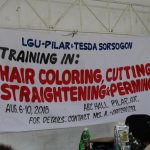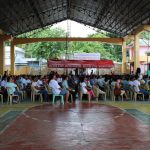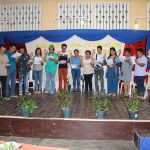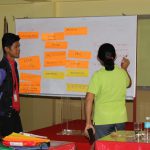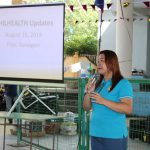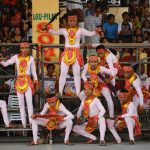PHYSICAL FEATURES
LOCATION
Pilar is located at the northwestern part of the province of Sorsogon which is at the southernmost tip of the Bicol Peninsula. It lies at 12 degrees 56' and 44 latitude and 123 degrees,39' and 52" longitude. it is 57 kilometers road distance from the provincial capital of Sorsogon and 47 kilometers south of the Regional Center of Legazpi City in Albay province.
It is bounded on the north by the province of Albay; on the east by the municipality of Castilla; on the south by Pilar Bay; and on the west by the municipality of Donsol.
By bus, Manila –Pilar travel time is 9 to 10 hours; by airplane,Manila-Legazpi is one hour plus a one-hour car-ride from Legazpi-Pilar.
CLIMATE
The climate of Pilar is Type 2 which has no dry season and with a very pronounced maximum rainfall from November to January. Rainy months coincide with the typhoon season.
Temperature ranges from 22 degrees Centigrade during the coolest month to 35 degrees Centigrade during the hottest month. Average temperature is 27 degrees Centigrade.
Three wind systems affect the area. The Northeast Monsoon prevails during the months of October to January. The easterly trade winds ( South Pacific Trades) come February to Mid may. The Southwest Monsoon wind prevails during the rest of the year.
TOPOGRAPHY
Pilar's terrain ranges from plain to hilly and mountainous. Plain and coastal plains are used as settlements and irrigated rice lands. Hilly lands and mountainous areas are devoted to coconut, upland agriculture, and other forestry uses.
WATER BODIES
Several major river systems drain the area, they empty to Pilar Bay and Ticao Pass. The northwest part is drained by tributaries to Ogod River which is the physical boundary with Donsol and empties to Ticao Pass. The northeast and central parts are drained by Malbog and Putiao Rivers. The east and southeast are drained by numerous creeks that meet and empty together to Panlatuan Bay.
GEOLOGY
A geological reserve of 217 million tons of limestone has been delineated in Pilar and Donsol in an area of 93 sq. km., possible use for the reserve is for lime production.
An inventory of pumice and lime has included deposits in Abucay and Cabiguan. The silica rich, vesicular,and very light materials are used in the garments industry for stonewashing. They are also used as filter materials, silica source and components of Lightweight paneling. The Kastila Cave in Abucay and Piot Cave I in Lungib have been identified as promising areas for guano production. Recently, San Jose Cave was discovered having vast deposits of Guano. Guano is rich in phosphatic minerals used in the manufacture of fertilizers.
POLITICAL SUBDIVISON
Pilar is composed of 49 barangays, 13 of which are considered Coastal Barangays while urban barangays comprise the Poblacion which is the urban center of the municipality and one considered as urban barangay which is situated at the junction of Pilar-Putiao National Road and the Maharlika Highway. The rest are considered rural barangays.
Pilar has two political districts ,Pilar I and Pilar II. These districts are also used as reference boundaries of the Department of Education.
POPULATION
The years before the last census of 2000 saw the increase of Pilar’s population by 37% while the provincial rate was 32 5. The impressive growth, however, has not been steady. It was marked by booms and stagnation.1980s to 1990s registered a slow growth in terms of population as this were the years when many natural calamities visited the municipality including the very strong typhoon Sisang which devastated the whole Poblacion area of the town wrecking almost all establishment, commercial and residential, along the coastline of the urban center. However, early 1990s marked a significant improvement in economic activities and soon businesses are on a healthy march forward. The total population of the municipality of Pilar is 63,871 as of 2007 NSO census of Population.
LANGUAGE
Almost 100% of the population had Bicol Dialect as mother tongue. The diversity of mother tongue had fairly reflected the immigration pattern of the town suggesting places of origin but Bicol dialects were lumped into one mother tongue that movement within the province and the region can not be deducted anymore.
Bicol is spoken by 95% of households. The rest speak Tagalog, Ilocano, and Bisaya. English can be understood by 80% of the population.
ECONOMIC PROFILE
AGRICULTURE
Despite efforts on diversification, Pilar’s agricultural economy remains to be heavily dependent on the monoculture of coconut which is planted to more than 70% of its total land area. As such, it is a major supplier of copra in the coconut oil milling industry in Bicol yet coconut farmers remain to be below the threshold level. Next to coconut. Rice is produced in 11% of its land, which is about 2,730 hectares but only 483 hectares are irrigated. Corn and root crops are also planted in upland farms as an alternative to rice.
Livestock is mainly raised at the backyard level, except for three contract-growers who each raises 5,000 to 7,000 birds per batch. Carabao is primarily raised as farm work animal.
Fishing ground for municipal fishing is the waters between Sorsogon and Masbate provinces. Fish caught are sold at the local public market. Some small-scale brokers also deliver catch to nearby urban center and quality species are brought to Metro Manila. The present Fishery Brokers’ Center located at Barangay Dao just beside the sea wall has an average volume of three tons of fishery products being transacted everyday.
With 330 hectares of fishponds, and still growing, Pilar is known for its palatable prawns and mud crabs available all year round
Cottage Industry using local raw materials such coconut, buri, abaca, bankuan, and anahaw are also thriving in the countryside.

